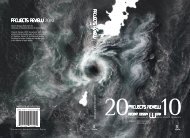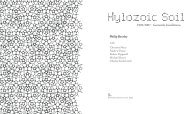The Inner Studio - Riverside Architectural Press
The Inner Studio - Riverside Architectural Press
The Inner Studio - Riverside Architectural Press
Create successful ePaper yourself
Turn your PDF publications into a flip-book with our unique Google optimized e-Paper software.
PART THREE | INNER RESOURCES<br />
patriarchal beliefs. <strong>The</strong> other great masculine artifact of our<br />
modern cities is infrastructure. <strong>The</strong>se enormous constructions are<br />
seldom thought of as “designed,” yet in their self-absorbed rationality<br />
they express the masculine, as do many performance-based<br />
workspaces such as offices, fast-food restaurants, and laboratories.<br />
Environments that show no regard for nurturing life, or that ignore<br />
basic human longings are evidence of overloaded masculine traits<br />
and are common throughout contemporary suburban and urban<br />
developments. Factories and malls that imperiously impose themselves<br />
on the agricultural land surrounding most cities represent the<br />
one-sided patriarchal values that grip modern planning debates.<br />
While they are usually the product of municipal or regional<br />
planning design studies, these environments signify a major victory<br />
of infrastructure and organization, characteristics necessary when<br />
going into battle, but less significant if the goal is to ennoble a<br />
human-centered life. <strong>The</strong> habitual overvaluation of one quality,<br />
usually the masculine, translates into abstract and counterintuitive<br />
spaces that have become the norm in North America. <strong>The</strong> resulting<br />
alienation and a lack of “place” are symptoms of the one-sided<br />
thinking that continues to dominate most urban design. Tools and<br />
their modern equivalents, which we see in the latest technological<br />
devices, belong to this category and speak to the penetrating role<br />
of the intellect that accompanies many of these inventions.<br />
Feminine: Mother Nature<br />
All those artifacts and places that are hollow, offer refuge, and can<br />
be filled through inhabitation or use symbolize the feminine built<br />
world. Churches are considered feminine because they contain the<br />
spirit of the Father. <strong>The</strong> unconscious is considered feminine<br />
because it is the source of all things or, as Jung liked to say, “the<br />
womb of the arts”–it is infinite and from it, consciousness emerges.<br />
Artifacts as diverse as ships, walled cities, public spaces, niches,<br />
gardens, and homes belong to a category of objects and places that<br />
have associations with the feminine. While men may be thought of<br />
as “king of the castle,” they are usually only in charge of fixing the<br />
house, while all the decisions that relate to the inside the house<br />
have traditionally been the domain of the feminine. Places that<br />
81





